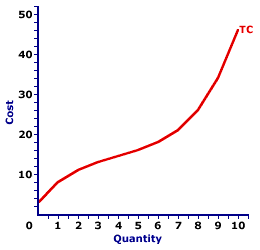
|
|
REALISM OF PERFECT COMPETITION: Perfect competition is an idealized market structure that does NOT exist in the real world. While some real world industries might come relatively close to a one or two of the four key characteristics of perfect competition, none matches all four sufficiently that we can declare a perfectly competitively industry. Some industries come close on the large number of small firms and the identical product characteristics. A few industries have relatively good, although not perfect, information about prices and technology. However, almost all industries fall far short of the perfect mobility characteristics.
Visit the GLOSS*arama
|
|


|

|
                           TOTAL COST CURVE: A curve that graphically represents the relation between the total cost incurred by a firm in the short-run production of a good or service and the quantity produced. The total cost curve is a cornerstone upon which the analysis of short-run production is built. It combines all opportunity cost of production into a single curve, which can then be used with the total revenue curve to determine profit. The marginal cost curve, THE focal point for the analysis of short-run production, is derived directly from the total cost curve. The shape of the curve reflects increasing marginal returns at small quantities of output and decreasing marginal returns at larger quantities. The total cost curve graphically represents the relation between total cost and the quantity of production. This curve can be derived in two ways. One is to plot a schedule of numbers relating output quantity and total cost. The other is to vertically add the total variable cost curve and the total fixed cost curve. The slope of the total cost curve is marginal cost. When constructing this curve, it is assumed that total cost changes as a result of changes in the quantity of output produced, while other variables like technology and resource prices are held fixed.| Total Cost Curve |  |
The graph at the right is the total cost curve for the short-run production of Wacky Willy Stuffed Amigos (those cute and cuddly lizards, snakes, armadillos and tarantulas). The quantity of Stuffed Amigos production, measured on the horizontal axis, ranges from 0 to 10 and the total cost incurred in the production of Stuffed Amigos, measured on the vertical axis, ranges from $3 to $46.The most striking feature of the total cost curve is its curvature. The total cost curve emerges from the vertical axis at $3, then twists and turns its way to $46. This curve begins relatively steep, then flattens, before turning increasingly steep once again. It is somewhat reminiscent of the total product curve. The reason is that both curves are guided by the law of diminishing marginal returns. A scenic trip along this curve reveals that the slope of the total cost curve flattens as the first four Stuffed Amigos are produced. This range of output corresponds with increasing marginal returns found in Stage I of production. Increasing marginal returns is what causes the total cost curve to flatten. Continuing this trip shows that the slope of the total cost curve becomes increasingly steeper after the fourth Stuffed Amigo is produced. Steeper and steeper. This range of output corresponds with decreasing marginal returns, and the extremely important law of diminishing marginal returns, found in Stage II of production. Deceasing marginal returns is what causes the total cost curve to become steeper and steeper and steeper. The total cost curve is frequently used with a total revenue curve to determine the profit maximizing level of production for a firm. However, this curve is perhaps most important as the basis for deriving the average total cost curve and the marginal cost curve. In particular, marginal cost is the slope of the total cost curve.

Recommended Citation:TOTAL COST CURVE, AmosWEB Encyclonomic WEB*pedia, http://www.AmosWEB.com, AmosWEB LLC, 2000-2024. [Accessed: April 19, 2024].
Check Out These Related Terms... | | | | | | | | | | |
Or For A Little Background... | | | | | | | | | | | | | | |
And For Further Study... | | | | | | | | | | | | | | | | | |
Search Again?
Back to the WEB*pedia
|



|

|
RED AGGRESSERINE
[What's This?]
Today, you are likely to spend a great deal of time browsing through a long list of dot com websites looking to buy either a birthday gift for your grandfather or a pleather CD case. Be on the lookout for empty parking spaces that appear to be near the entrance to a store.
Your Complete Scope
This isn't me! What am I?
|

|
|
Helping spur the U.S. industrial revolution, Thomas Edison patented nearly 1300 inventions, 300 of which came out of his Menlo Park "invention factory" during a four-year period.
|

|
|
"The past is a foreign country; they do things differently there." -- Leslie Poles Hartley, Writer
|

|
AFBD
Association of Futures Brokers and Dealers (UK)
|

|
|
Tell us what you think about AmosWEB. Like what you see? Have suggestions for improvements? Let us know. Click the User Feedback link.
User Feedback
|


|


